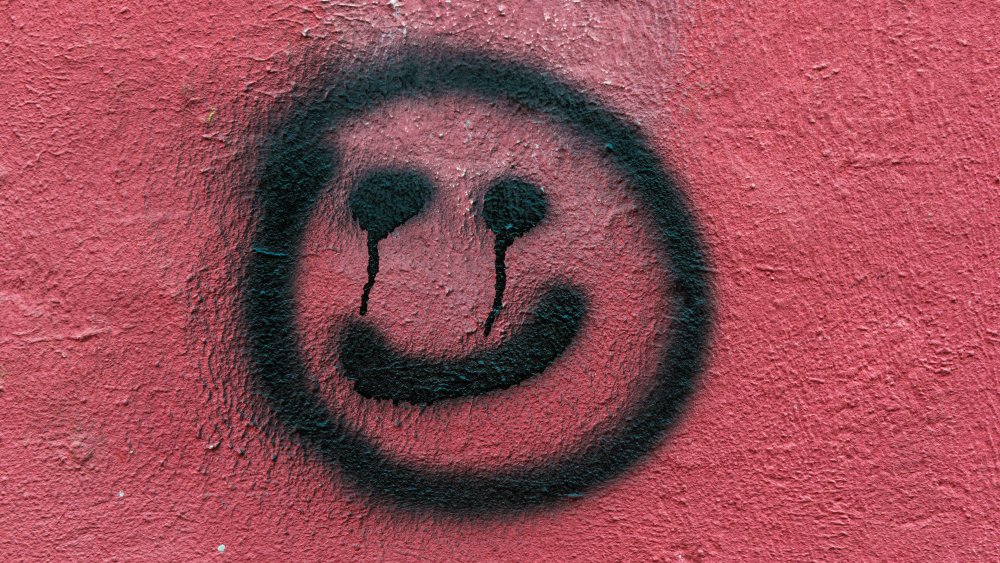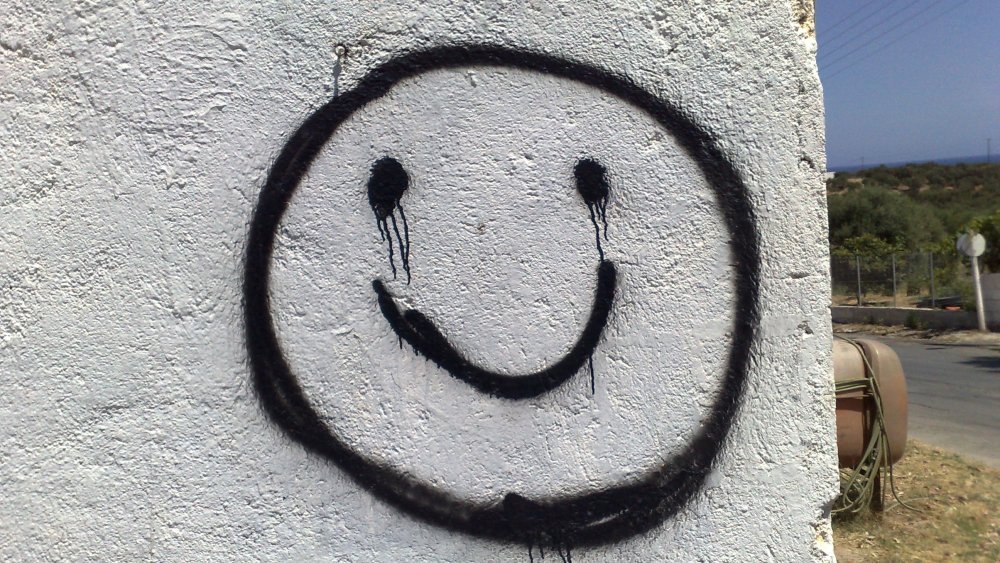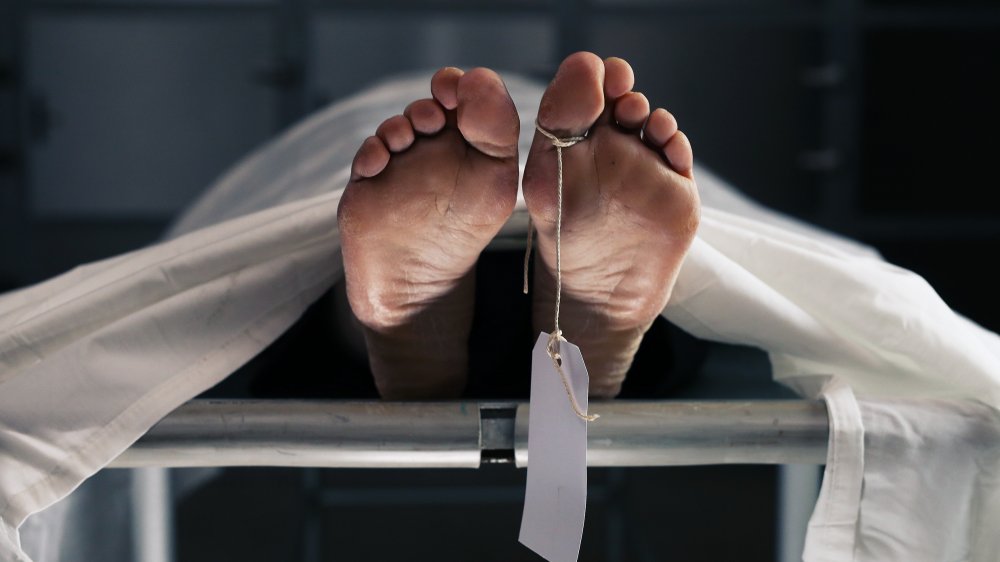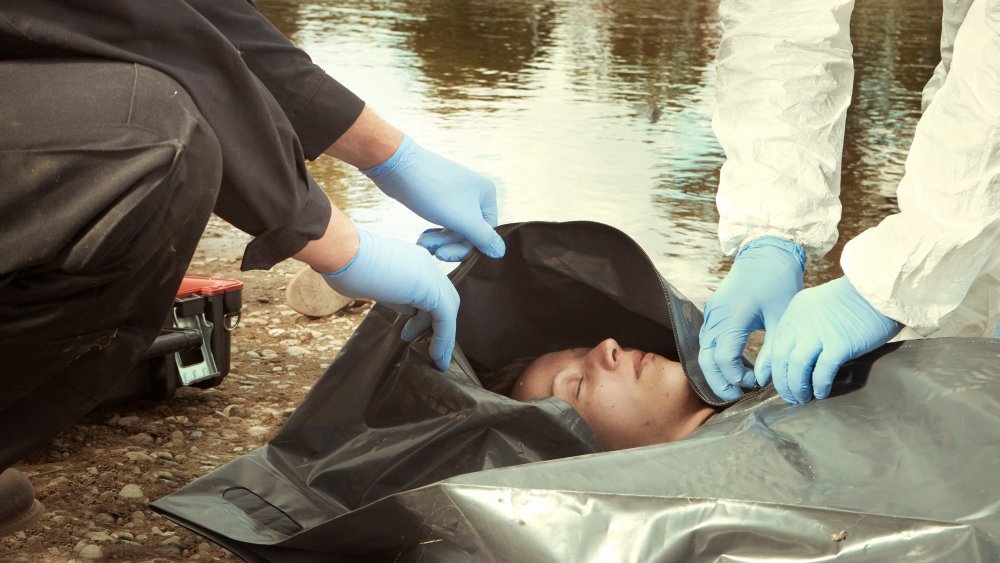The Untold Conspiracy Of The Smiley Face Murders
Serial killers are terrifying. Crimes of passion are comprehensible because we can at least see the human emotion behind them, but the well-planned and calmly executed crimes of a serial killer are so horrifically foreign to normal people they fascinate. That's one reason why serial killers are so often the subjects of thrillers and horror stories—the idea that we could be targeted by a killer for reasons beyond our understanding is chilling.
We take comfort in the fact that society usually detects these insane people—or at least their patterns. We may never know who the Zodiac Killer really was, for example, but we know that their activities stopped at a certain point in time because we saw their pattern. But according to a small group of law enforcement professionals, there's a prolific serial killer—or killers—working in the US right now who are so subtle and so good at what they do they're practically invisible.
Retired New York City Police detectives Kevin Gannon and Anthony Duarte, joined by criminal justice professor Dr. Lee Gilbertson, believe that a group of serial killers have been murdering young men around the country and making their deaths look like accidental drownings. The FBI and other experts have dismissed their claims as a conspiracy theory. The details are blood-curdling, and true or not the story of the Smiley Face Murders is one of the most terrifying things you'll hear about today.
It all starts in 1997
As Rolling Stone reports, the Smiley Face Murders story begins in 1997. That year, Fordham University student Patrick McNeill walked out of the Dapper Dog in New York City on the Upper East Side and disappeared. According to the Fordham Observer, McNeill became extremely intoxicated, throwing up in the bar's bathroom, and went outside to wait for a ride home with a friend. When the friend failed to appear, he was last seen walking towards the subway station—followed by a van that had been double-parked on the street outside.
Detective Kevin Gannon caught the case, and a month later McNeill's body was found floating in the East River. The medical examiner called the death an "undetermined drowning," citing his high blood alcohol level—implying a drunken McNeill simply fell into the river and drowned. But Gannon was convinced that it was clearly a murder. There is evidence that Patrick McNeill was bound and abused before drowning. His body exhibited signs of having been dead before being placed in the river, as well. Gannon swore to McNeill's parents that he would continue the investigation. He was joined by fellow detective Anthony Duarte, and eventually criminal justice professor Lee Gilbertson, in the belief that McNeill was a murder victim.
For more than 20 years, the trio have compiled evidence they believe indicates that Patrick was the first known victim of the Smiley Face Killers.
The 'Smiley face' name comes from creepy graffiti
Lots of at-large serial killers get a nickname. Jack the Ripper. The Zodiac Killer. The Golden State Killer. Son of Sam. These nicknames usually come from some detail of their crimes, and the Smiley Face Killers are no different.
According to The Daily Beast, while investigating the growing number of deaths they believe are linked to a single serial killer or coordinated group of killers, retired police detectives Kevin Gannon and Anthony Duarte noticed a creepy detail: At every location of a victim, there was a smiley face of some sort painted on a visible nearby landmark. In fact, Gannon and Duarte claim that there are no fewer than 13 symbols commonly found near the location where alleged victims of the Smiley Face Killers have been found.
As Rolling Stone notes, however, the smiley face is actually one of the most common graffiti tags in the country, and the faces noted by Gannon and Duarte vary significantly in style, format, and even apparent date of application. Since bodies float, it's impossible to state with any real accuracy precisely where one will be spotted, which leads many law enforcement experts to dismiss the idea that a serial killer or killers would be taunting police with smiley face graffiti.
There's a victim profile
One of the more compelling aspects of the Smiley Face Killer theory is how similar most of the victims are, which supports the idea that the killer is targeting a specific type of person. As The Daily Beast reports, the victims are all young men attending college. They generally get good grades and have professional aspirations. They're usually athletic and popular, they're usually white, and they have almost always been out drinking at bars with friends prior to their disappearance. Some of the more recent victims that investigators have linked to the Smiley Face Killers have been openly gay. This consistency in the victims certainly supports the theory that one person or group is behind their deaths.
On the other hand, as the non-profit Center for Homicide Research has pointed out, alcohol would also explain why a young man would become confused and fall into a river and drown. Young men are statistically shown to be more likely to engage in risky behaviors—especially when alcohol is involved. In other words, since binge-drinking and going home alone is not uncommon for young men, it's not surprising that they are over-represented in drowning deaths.
Still, the idea that a serial killer is going after young, popular students with bright futures is especially horrifying, and definitely adds to the compelling nature of the theory.
There might be many Smiley face killers
What really sets the theory behind the Smiley Face Killers apart from other stories about serial murderers is the belief that it's not a single killer. Former detectives Kevin Gannon and Anthony Duarte, along with criminal justice professor Lee Gilbertson, believe that the Smiley Face killings are in fact being conducted by a large, coordinated group of people. As reported by Heavy, Gannon believes there may be more than a thousand people involved, broken up into "cells" of 12-15 in different cities.
As The Seattle Times notes, this would explain how some of the victims identified by Gannon and Duarte went missing on the same day in different cities. He also theorizes that membership in this murderous gang might change over the years as some members age out or die and others are recruited. If Gannon is correct, acting as a group would also help confuse any investigation, as law enforcement would naturally assume a single perpetrator and be thrown off the scent if different people were involved, especially if they had no connection to the victims.
Frighteningly, Gannon notes that the Smiley Face Killers have become more active in the last few years. He theorizes that this is because law enforcement has failed to take them seriously, and so the group is feeling more secure and confident in their ability to kill with impunity.
There might be as many as 335 Smiley face murder victims
Serial killing is hard work. It involves selecting a target, surveilling them, kidnapping them or choosing a place to commit the deed, and then possibly staging the scene or constructing some other calling card. The most prolific serial killer on record is Luis Garavito. According to Britannica, Garavito confessed to killing 140 people—mostly poor children—and was convicted of 189 murders (he's currently serving an 835-year prison term).
If Kevin Gannon, Anthony Duarte, and Lee Gilbertson are right, the Smiley Face Killer(s) puts Garavito to shame. According to Rolling Stone, the investigators have a database that identifies an astonishing 335 possible victims based on the profile they've developed and the physical characteristics of the crime scenes. It should be noted that Gannon, Duarte, and Gilbertson admit these are "possible" victims—there's no way to prove these deaths are linked. The circumstantial evidence is compelling, however. The victims in the database exhibit many characteristics that hint they spent a significant time outside the water before being discovered, and many of the postmortem examinations show similar toxicology reports and the presence of land insects that wouldn't be found in the water.
What's frightening is that even if the investigators are only 50 percent correct, we're still talking about one of the most prolific serial killers in history.
The cause of death is controversial
TV shows make forensic science seem a lot more advanced and reliable than it actually is. One example is how easily and accurately forensic scientists can determine precise causes of death. In reality, we live in a world where the term "undetermined drowning" gets used a lot. As the International Journal of Psychiatry in Clinical Practice explains, it's possible to conclude that someone drowned but have no hint as to why. Forensic experts often can't tell if someone drowned by accident (for example, being very inebriated and falling into a river) or due to another cause.
As Rolling Stone notes, almost all of the deaths that former detectives Kevin Gannon and Anthony Duarte believe are connected to the Smiley Face Killer have been ruled either accidental or undetermined drownings. The use of "undetermined" usually means there's no clear evidence of foul play.
Gannon and Duarte argue that the circumstantial similarities between the crimes and the physical evidence indicates that the drownings weren't accidents—for example, some of the victims have been found weeks after they disappeared, but appear to have been in the water for a much shorter period of time. If these cases were classified as homicides, the police would be forced to investigate. Others argue that medical examiners know their business, and the reason they don't rule the deaths that way is because there's simply no evidence to support the theory.
One of the Smiley face murder victims may have been targeted twice
In many of the deaths that Kevin Gannon and Anthony Duarte link to the Smiley Face Killer, a van has been spotted near where the victim was last seen alive. Which means it's possible that one of the Smiley Face Killer's victims was targeted twice—which also means the killers aren't easily scared.
As reported by The Daily Beast, a young man named Dakota James contacted his friend Shelley on December 15, 2016. It was late, and James was very drunk after going out with co-workers to a bar. He was confused and upset about something. When she tracked him down, she saw a visibly confused James walking towards an SUV that was sitting facing the wrong way in the street. Shelley intervened and got James home safely.
Five weeks later, James disappeared. Once again, he'd gone out to drink with friends. Forty days after he disappeared, his body was found floating in the Ohio River. According to Gannon and Duarte, smiley face graffiti was found a short distance away, and there is evidence that James was drugged and strangled prior to being drowned. The coroner disagreed, ruling his death an accident. But if Gannon and Duarte are right, that means the killer or killers were thwarted—and seen by a witness—but patiently continued to wait for their opportunity to murder Dakota James.
The FBI disagrees
While former NYPD detectives Kevin Gannon and Anthony Duarte, along with criminal justice academic Lee Gilbertson, have compiled an impressive amount of evidence implying that hundreds of drowning victims were actually murdered by a cabal of serial killers working as a team, it's all circumstantial. There is no direct evidence that these deaths are linked, much less caused by a single group or individual.
In fact, in 2008, after Gannon and Duarte's investigation had been going on for more than a decade, the Federal Bureau of Investigation (FBI) took a look. Their conclusion was simple: They found no link between the deaths, and most of the drownings were in fact accidental. In 2010, the nonprofit Center for Homicide Research performed an in-depth study of the Smiley Face Killings, and also concluded that it was little more than a conspiracy theory.
For their part, Gannon and Duarte believe there is a fundamental disconnect between law enforcement and forensic professionals. As Rolling Stone reports, Duarte says that the medical examiner and the police are each waiting for the other to provide evidence of homicide, and as a result these cases simply get pushed aside by more urgent investigations. The evidence of homicide is never officially collected as a result, and everyone simply accepts that the drowning was accidental.
The Smiley face killers use the dark web
If the Smiley Face Killers are real, there's one good reason it's been so hard to produce real evidence of their coordinated serial killing: According to The Daily Beast, they apparently use the Dark Web to organize and communicate.
The Dark Web is a network of websites that require a special web browser using the anonymous Tor protocol to access. While many people use the Dark Web in order to preserve their privacy, it's known that many criminal organizations also use the Dark Web in order to freely sell illicit things like weapons or drugs, or to trade illegal information. That makes the Dark Web perfect for a gang of killers to recruit more members, identify victims, and coordinate actions.
According to former detective Kevin Gannon, he and his fellow investigators once got close to one of these websites. He was given a Dark Web address, but when he accessed the site, he faced a password prompt—and a demand that he turn on his camera so the site's administrators could see who was there. He didn't have the password and wouldn't have agreed to turn on the camera in any event.
As detractors of the theory point out, this also means there is no actual evidence that any of these Dark Web sites actually exist. Like the Smiley Face Killer gang itself, they exist only in theory for now.
A date-rape drug is involved
All of the young men who Kevin Gannon and Anthony Duarte believe to be victims of the Smiley Face Killers were out drinking before they disappeared, but the two retired police detectives believe there's another substance involved: Gamma-hydroxybutyrate, usually referred to as GHB—a notorious "date rape" drug.
As WebMD explains, GHB is colorless and tasteless, and can cause extreme sedation and complete memory loss. Its lack of taste or color make it very easy to slip into someone's drink. According to E! Online, GHB has been found in about 30 of the drowning victims linked to the Smiley Face Killers—but Gannon and Duarte think the number is much, much higher. They told Rolling Stone the number is probably closer to 99.9 percent of the cases. The problem, they explain, is that GHB isn't usually included in toxicology reports. This has led many families to authorize private toxicology scans, which have revealed the presence of the drug.
Complicating this is the fact that although GHB is illegal except under very specific medical uses, it's still a common recreational party drug. It's not at all impossible that the victims voluntarily used the drug, and that their inebriation as a result contributed to their accidental deaths.
The victims' bodies are staged
Perhaps the creepiest detail to emerge from the investigation conducted by Kevin Gannon, Anthony Duarte, and Lee Gilbertson is the fact that many of the bodies appear to have been staged. As they write in the book they published in support of their theories, Case Studies in Drowning Forensics, one example is the body of Tommy Booth, who vanished in January 2008. His body was found two weeks later, face down in the water with his arms folded neatly under him. Sticks had been pushed into the soft dirt at strategic places to hold his body in place, making the possibility that his body had been purposefully posed and placed in that spot very clear.
As Oxygen notes, there are other examples. Todd Geib was found posed to look as if he were out for a swim, and Chris Jenkins was found floating in the Mississippi River on his back, with his arms crossed over his chest.
As Gannon, Duarte, and Gilbertson note in their book, the chances that these poses were accidental are very slim. And the chances that the sticks holding Booth's body in place became wedged there naturally are extremely low. All the evidence points to the bodies being staged in various ways.
The Smiley face murders might be a gang initiation rite
According to The Daily Beast, Kevin Gannon, Anthony Duarte, and Lee Gilbertson have people they suspect are part of the Smiley Face gang—but they won't say who they are. That leaves the purpose of the group—if it exists—a mystery. Theories as to why a group of people are targeting and killing young men with bright futures vary, but one stands out in terms of sheer horror.
As noted by Oxygen, one leading theory is that the murders are part of a gang initiation rite, similar in some ways to the old urban legend that gang initiates drive around at night with their headlights off, charged with killing the first person to flash their lights at them. The idea is to prove your loyalty and willingness to do whatever you're asked—even kill an innocent stranger.
This theory would explain the consistent profile of the victims, as the ritualistic nature of the killings would be an important component. It might also explain the graffiti as the initiates tagging the scene to prove to the gang that they committed the crime. There's no evidence that this is the case, of course—but it's a terrifying thought.












